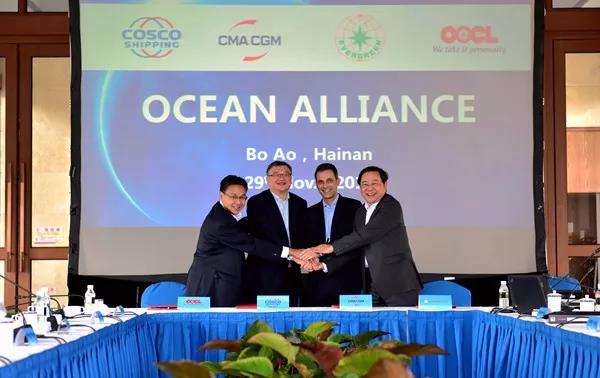Shipping alliances restructure services to absorb mega ship influx in 2018

THE flood of tonnage entering the market has prompted container shipping alliances to restructure or change their service networks in 2018.
Most of that extra capacity is to be delivered to the Ocean Alliance, with SeaIntel saying that the alliance's fleet of mega ships will expand by 60 per cent early on in 2018.
According to the analyst, a total of 108 mega ships will be delivered in 2018, doubling the number currently in operation, reported IHS Media. There are 78 mega ships with a capacity of 10,000 TEU or above for a total of 1.2 million TEU scheduled for delivery next year, according to IHS Markit.
Of the three alliances - THE Alliance, 2M (Maersk, MSC plus HMM) and Ocean Alliance (Cosco Shipping, CMA CGM, OOCL and Evergreen) - 2M and THE Alliance have a development plan for the phase-in of new deliveries in 2018 that aims to augment existing services and reduce unit costs on those services by deploying a few more ultra-large ships.
The same cannot be said for the Ocean Alliance, and the concern for shippers is that shipping lines will need to revise the structure of their existing network to optimise the deployment of the fleet portfolio.
"Major restructuring of networks is typically seen to take place in the first quarter and early [second quarter] in the wake of Chinese New Year. This timing coincides well with the delivery profile for 2018," SeaIntel said.
"Consequently, shippers should prepare themselves for a 2018 wherein the network structures of 2M and THE Alliance are likely to undergo only smaller modifications, but wherein we will see an Ocean Alliance potentially change the network more drastically, offering new products and network structures, driven by the rapid delivery of large vessels."
In addition to the network restructuring, the Ocean Alliance will also have to deal with the Cosco Shipping-OOCL takeover. That acquisition is expected to be finalised over the next few months, and although the plan is for OOCL to continue operating under its own brand, there might be some additional service changes on the horizon.
Apparently unruffled by the merger of its three Japanese members, THE Alliance has unveiled its new service offering from April 2018 when the Ocean Network Express (ONE) begins operations. Hapag-Lloyd, ONE, and Yang Ming will offer 33 services covering all the east-west trade lanes and connecting 81 ports, the alliance members said in a statement.
Commenting on the success of its cooperation since launching in April 2017, THE Alliance member carriers said: "After one year of cooperation we are proud to say that our services and the network improved significantly."
The three carriers are planning to deploy a fleet of 250 ships in the Asia-Europe, North Atlantic, trans-Pacific trade lanes, as well as in services to the Middle East and the Arabian Gulf-Red Sea.
The new offering will feature eight services in the Asia-Europe trade including three services covering the Mediterranean market, while 16 joint services will be operated by THE Alliance members on the trans-Pacific trade. Seven loops will serve the North Atlantic trade covering North European and Mediterranean ports as well as those in the US, Canada and Mexico, and two in the Middle East.
US, Europe, Asia freight rates drop 2pc to US$1,134 per FEU in week of Dec 11

THE World Container Index (WCI), a composite of container freight rates on eight of the world's busiest routes to and from the US, Europe and Asia, decreased by two per cent last week to US$1,134 per 40 foot container (FEU), according to Drewry.
On a year-on-year basis the index fell 20 per cent, the data reveals.
Year-to-date the average composite index of the WCI stood at $1,466 per FEU, which is $128 less than the five-year average of $1,595 per FEU, Drewry said.
Freight rates on the Asia-Europe and transpacific routes softened last week, as the slack winter season is gripping the major east-west trades. The WCI assessed by Drewry on the Shanghai-Rotterdam route was $31 lower than the previous week at $1,376 per FEU. Compared to the same period in 2016 rates are down 19 per cent.
Rates between Shanghai and Los Angeles declined by $20 per FEU and rates between Shanghai and New York dropped by $13 to $1,867 per FEU. Rates on the Shanghai-Los Angeles and Shanghai-New York routes are down 27 per cent and 25 per cent year on year, respectively, according to Drewry.
"We expect the mid-December GRIs (general rate increases) to be deferred in the wake of soft demand," commented Drewry.
Air cargo volumes in Shanghai in 2017 hit 4 million tonnes

SHANGHAI airports' cargo volumes in 2017 have for the first time exceeded four million tonnes. Prior to this year, only Hong Kong and Memphis have achieved similar results.
In Shanghai freight moves through two airports in the city, Pudong International (PVG) and Hongqiao International (SHA). The majority of the city's air freight is handled at PVG, where the UPS transit centre, DHL's North Asia hub and FedEx's international cargo express centre are all located.
Combined, the airports have seen steep growth over the last 15 years, with volumes doubling between 2002 and 2005 to two million tonnes and topping three million tonnes by 2010, reported New York's Air Cargo World.
(Source:HKSG-GROUP)

|
